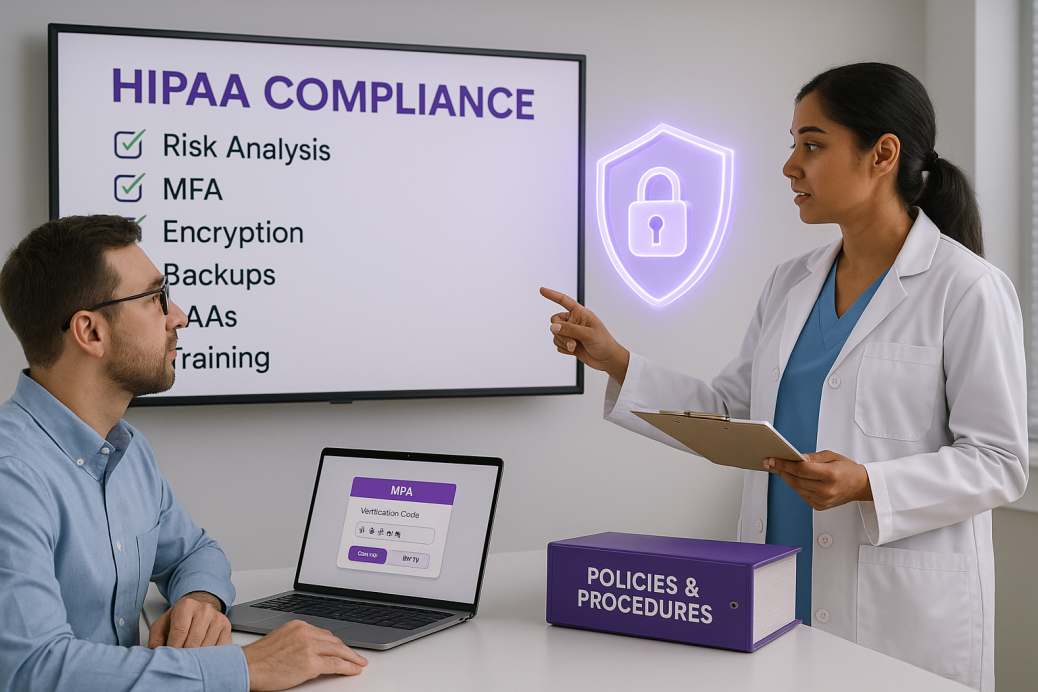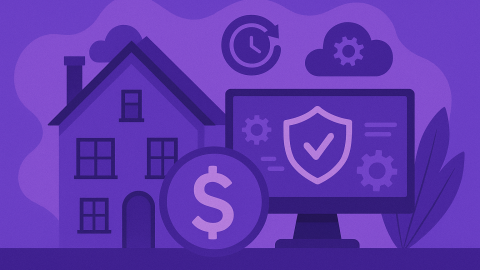HIPAA in 60 Seconds
HIPAA is a U.S. law that says: if you store, use, send, or see patient health information (called PHI), you must protect it, limit who can access it, and prove you’re doing both. If something goes wrong (a breach), you must tell patients and regulators within specific timelines.
You’re covered by HIPAA if you are:
- A healthcare provider, health plan, or clearinghouse (a Covered Entity), or
- A vendor/partner that handles PHI for any of the above (a Business Associate).
You don’t have to be big to be audited or fined. Plenty of small practices and small vendors have been penalized because they didn’t have the basics in place.
The Three HIPAA Rules (No Legalese)
- Privacy Rule – Only the right people, for the right reasons, should see patient info.
- Security Rule – Put technical and administrative protections around electronic PHI (ePHI).
- Breach Notification Rule – If ePHI is exposed, you usually have up to 60 days to notify patients and the government.
If you can show your homework—that you know your risks, implemented protections, trained people, and practiced what to do when things go wrong—you’re in good shape.
The Six Building Blocks of “Practical” HIPAA
Think of HIPAA like building a safe clinic or vendor operation. These are your bricks:
1) Risk Analysis & Risk Management
- What it means: Make a list of where PHI lives (email, laptops, EHR, billing software, backups, etc.), who has access, and what could go wrong.
- Do it yearly (or after big tech changes) and write down how you’ll fix the gaps.
2) Access Control
- Give people only what they need to do their job (least privilege).
- Turn on multi‑factor authentication (MFA) for email, VPN, EHR, admin tools—everywhere.
3) Device & Data Protection
- Encrypt laptops, phones, and storage.
- Use EDR (endpoint detection & response) and mobile device management (MDM) so you can lock or wipe lost devices.
- Use secure messaging/email when sending PHI. Don’t use iMessage, WhatsApp, or personal Gmail for PHI.
4) Logging, Monitoring & Backups
- Log who accessed PHI and review it (or have a managed SOC do it) so you can spot suspicious behavior.
- Keep immutable/offline backups (backups that ransomware or a rogue admin can’t delete) and test restores.
5) Vendors & BAAs
- Anyone who touches PHI for you must sign a Business Associate Agreement (BAA).
- Keep a list of all those vendors and review them annually.
6) Policies, Training & Incident Response
- Write simple policies: who gets access, how you remove access, how you patch systems, how you respond to a breach, etc.
- Train people at hire and yearly.
- Have a breach plan and practice it (tabletop exercise). That way, if the worst happens, you already know what to do.
What Regulators Keep Fining People For (So You Can Avoid It)
- No current risk analysis (or one that’s too generic to be useful).
- No MFA on email / remote access / admin tools.
- Unencrypted laptops or phones with PHI.
- No audit logs or nobody looking at them.
- No BAAs with vendors who clearly see PHI.
- Ransomware + no clean backups = total disaster.
The HIPAA Starter Plan (0–30–90 Days)
First 7 Days (Quick Wins)
- Turn on MFA everywhere (email, VPN, EHR, admin accounts).
- Encrypt every laptop and phone that can touch PHI.
- Make sure you have backups of critical systems and Microsoft 365/Google Workspace (native recycle bins aren’t enough).
- Collect your vendor list and sign BAAs where missing.
By Day 30
- Complete a Security Risk Analysis (even a lightweight one if you’re starting).
- Write a basic Incident Response Plan (who calls whom, how to isolate a device, who talks to patients/media/regulators).
- Turn on audit logging (or hire a managed SOC to watch it 24 × 7).
- Choose a secure messaging/file-sharing platform for PHI. Ban informal texting for PHI.
By Day 90
- Build your Risk Management Plan (what’s getting fixed, by when, and by whom).
- Run a breach tabletop exercise (simulate a ransomware event). Fix what you learn.
- Finalize policies and training. Track who completed training and when.
- Ensure immutable backups are in place and test a restore.
Everyday Habits That Keep You Safe (and Compliant)
- De-provision access the same day someone leaves.
- Quarterly access reviews: does everyone still need what they have?
- Patch fast: critical updates within 30 days (or document why you can’t).
- Phishing simulations & reminders: people are your best (or worst) control.
- Centralize all PHI where IT can protect and log it (don’t let it spread across personal devices and shadow tools).
What To Do When Something Goes Wrong (Simple Steps)
- Stop the bleeding: isolate the device/account, reset passwords, lock tokens, pull logs.
- Figure out what was accessed: use your logging to see who saw what.
- Do the 4‑factor risk assessment (required):
- What info was involved?
- Who saw it?
- Was it actually viewed or just exposed?
- What did you do to fix/contain it?
- If you can’t prove low risk, it’s a breach—start the 60‑day clock to notify patients and HHS/OCR.
- Document EVERYTHING: actions, timelines, who you notified, and your improvements to prevent next time.
Simple Glossary (No Acronyms Left Behind)
- PHI – Protected Health Information: anything that can identify a patient + health info.
- ePHI – PHI stored electronically.
- BAA – Business Associate Agreement: the contract you sign with vendors who handle PHI.
- MFA – Multi‑factor authentication: extra step to prove it’s you (app, token, etc.).
- EDR – Endpoint Detection & Response: advanced antivirus that can isolate infected machines.
- MDM – Mobile Device Management: tool to enforce encryption, wipe lost phones, etc.
- SIEM/SOC – Systems and people watching your logs 24 × 7 for threats.
- Immutable backup – A backup that can’t be changed or deleted.
- Tabletop exercise – A practice run for your breach plan.
One-Page Self‑Check (Print This)
- Do we have a current written Security Risk Analysis?
- Do we have a Risk Management Plan that says how/when we’ll fix gaps?
- Is MFA turned on everywhere (email, VPN, EHR, admin)?
- Are all laptops/phones encrypted and managed (can we wipe them)?
- Do we have immutable/offline backups and proof of test restores?
- Are audit logs centralized and reviewed (internally or by a SOC)?
- Do we have signed BAAs for every vendor with PHI?
- Do we train staff at hire and annually, and keep records?
- Do we have a breach plan and have we practiced it?
- Can we show that only the minimum necessary people can access PHI?
If you said “no” to two or more, you’ve got easy places to start.
How Affant Makes This Manageable (So You Can Get Back to Care)
- HIPAA Risk Analysis in a Week – Plain‑English findings, prioritized fixes.
- Managed HIPAA Security Stack – We configure and co-manage MFA, EDR, SIEM/SOC, DLP, and immutable backups—24 × 7.
- Policies, Training & BAAs – Ready-to-use templates, tracking, and reporting.
- Breach Tabletop & IR Retainer – Practice the plan; we’re on call if you need us.
- Audit / Insurance Support – We package evidence the way auditors and underwriters want it, saving you weeks of back-and-forth.
Final Takeaway
HIPAA doesn’t have to be scary or complicated. If you know your risks, control access, encrypt and back up data, watch your logs, train your people, and plan for the bad day, you’ll be in a far better position than most organizations. And you’ll sleep better.
Want a no-jargon snapshot of where you stand (and what to fix first)? Book Affant’s HIPAA Readiness Call. Thirty minutes, zero judgment, and you’ll leave with a short list you can actually act on this quarter.











